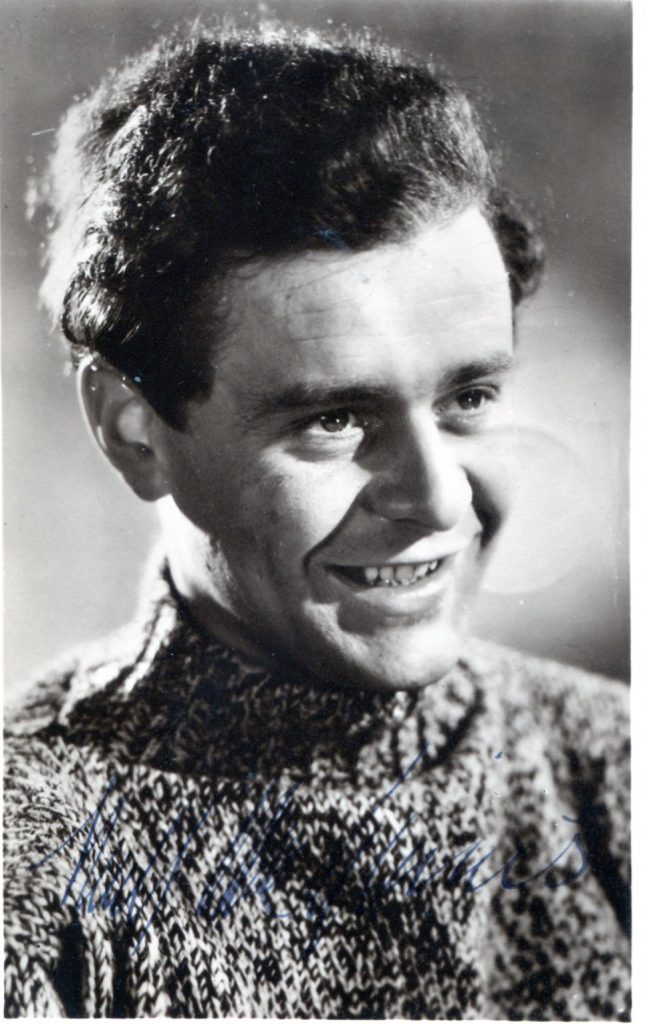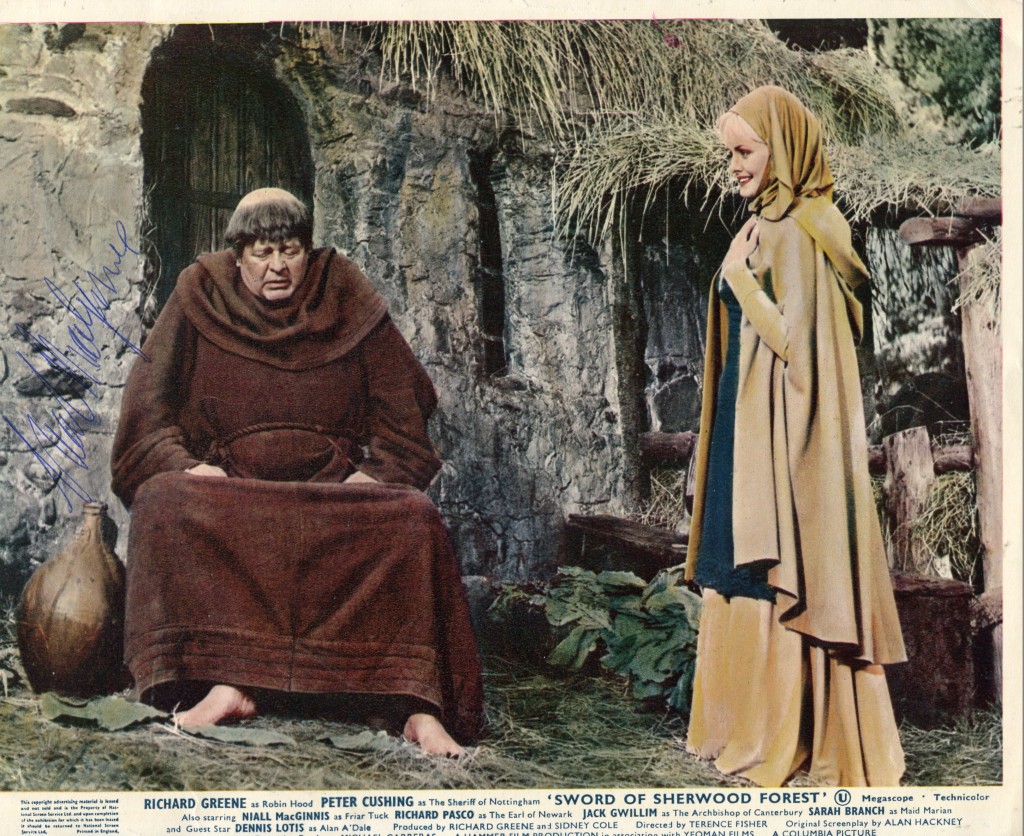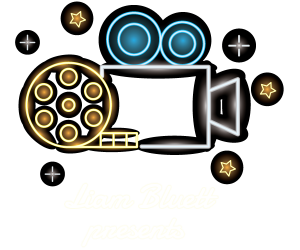

Dictionary of Irish biography
MacGinnis, (Patrick) Niall (1913–77), actor and medical doctor, was born 29 March 1913 at 25 Oakley Road, Ranelagh, Dublin, the eldest of two sons of Patrick F. MacGinnis (1873–1933), medical doctor and bacteriologist, and his wife Mary Josephine (née Kelly).
After attending Stonyhurst College (1925–9), where he won prizes for elocution and played rugby and cricket, he studied medicine at TCD (1930–33). Drawn to acting, he abandoned his studies and first appeared on stage at the Peacock Theatre in Dublin in 1931. Acting with the Sheffield Playgoers before undertaking formal training with the Sheffield Repertory Theatre (1932–3) (his parents then residing in nearby Chesterfield), he toured Ireland that summer with Dorothy Grafton’s company. During a spell with the Gate Theatre, Dublin (1933–4), he played the Ghost against the Hamlet of Micheál MacLiammóir (qv), and successfully reprised the role in the summer of 1935 with the Gate players at the Westminster Theatre, London. He had already made his London debut at the New Theatre in September 1934 in a minor role.
MacGinnis made his film debut in The luck of the Irish (1935; dir. Donovan Pedelty, from the novel by Victor Haddick (qv)), before taking a lead role as the surreptitious IRA leader Nick O’Dea in Ourselves alone (1936; dir. Brian Desmond Hurst (qv)). Commencing a sequence of nautically themed roles in his early film career, he played a trawlerman in Turn of the tide (1936), opposite Geraldine Fitzgerald (qv), set amongst a fictionalised North Sea herring fleet sailing out of Grimsby. Cast as the lead protagonist in Michael Powell’s The edge of the world (1937), MacGinnis served as unofficial medical officer during the shoot on Foula, the most westerly of the Shetland Islands. Powell was inspired by the real-life evacuation of St Kilda in the Hebrides, casting MacGinnis prominently in this fictionalised semi-documentary, which addressed the contemporary depopulation of the Scottish isles.
Lauded in the role of Mat Burke in Eugene O’Neill’s ‘Anna Christie’ at the Westminster Theatre in London (April 1937), he appeared regularly with London’s Old Vic company, playing Malcolm against Laurence Olivier’s Macbeth (November 1937). He took various roles with the Longford players during their 1937–8 London season, while living on the Thames in a converted sail boat, the Herimone. In the late 1930s, MacGinnis completed his medical training at Charing Cross Hospital, London, gaining membership of the RCS and the licentiate of the RCP (1944), thus allowing him to practise medicine; he served as a surgeon-lieutenant in the RNVR during the second world war. MacGinnis would undertake an annual locum to retain his registration, and sometimes served as a ships’ doctor when between roles.
Commissioned by the UK Ministry of Information, Powell cast MacGinnis (alongside five others who had appeared in The edge of the world) in 49th parallel (1941) as Vogel, a member of a German U-Boat crew stranded in Canada who undergoes a reappraisal of his Nazi militarism when the crew encounter a Hutterite community, with which he wishes to remain, leading to his summary execution after a court martial by his crew mates. Further patriotic roles included the Irish submariner Mike Corrigan in We dive at dawn (1943; dir. Anthony Asquith), and a wounded RAF pilot seeking safe nesting for local rare birds in the quaint Tawny pipit (1944). After a supporting role in Frank Launder’s Captain Boycott (1947), he played a scheming rum trader in Diamond city (1949), alongside Honor Blackman and Diana Dors, set in the South African mines of 1870. Cast by Laurence Olivier in minor but striking ensemble roles, notably as the Irish Captain Macmorris in Olivier’s film of Henry V (1944) – the battle of Agincourt scenes being filmed at Powerscourt, Co. Wicklow – and as a sea captain (a character devised for the film version) in Hamlet (1948), MacGinnis acted with the Old Vic in many stage productions, featuring in Olivier’s production of ‘Caesar and Cleopatra’ by George Bernard Shaw (qv) for the 1951 Festival of Britain (the play successfully translated to Broadway (autumn 1951–April 1952)), and playing Pompey in Shakespeare’s ‘Antony and Cleopatra’.
MacGinnis took the eponymous lead as the heretical monk in Martin Luther (1953), a joint USA–West German production with a mostly British cast, directed by Irving Pichel and funded by the Lutheran church. MacGinnis’s physical likeness to extant portraits of Luther was noted by many reviewers of a film in which dramatic development was swamped by overly detailed plotting and historical settings; the Guardian noted that ‘it probably needs Bernard Shaw to make a drama out of what was principally a theological argument’ (Guardian, 24 January 1956).
Further career high points in period costume were in Knights of the round table (1953) as the Green Knight, and as Parmenio in Alexander the Great (1955), with Richard Burton and Fredric March. His King Menelaus in Helen of Troy (1956) and a memorable Zeus in Jason and the Argonauts (1963) both embodied his maturing gravitas. He returned to Dublin for a season of plays by Denis Johnston (qv) at the Gaiety Theatre (1956).
Perhaps his greatest role was as the Janus-like Dr Julian Karswell in Night of the demon (1957) (shortened by twelve minutes and retitled Curse of the demon for the US market), partially inspired by the real-life occultist medium Aleister Crowley and based on the classic Edwardian horror story ‘Casting the runes’ (1911) by M. R. James. Directed by Jacques Tourneur, this classic British horror film saw MacGinnis play a devil worshipper as affable and approachable, with almost sympathetic malice, against American parapsychologist Dr John Holden (Dana Andrews) who visits London in an attempt to expose him. Read by some as an indictment of the oaths required to assure political compliance in McCarthyite America (the deeply engaging dialogue addresses the scientific value of scepticism and the hysteria of mass, post-war UFO sightings in America), the film has been hugely influential in the genre.
Other notable film roles were as Roulin in Vincente Minnelli’s Lust for life (1956), starring Kirk Douglas (as Vincent Van Gogh) and Anthony Quinn (as Paul Gauguin), and as Michael O’Leary in Shake hands with the devil (1959), a predictable romance-adventure starring James Cagney set amid the Irish troubles of 1921, and the first international feature film produced at Ardmore Studios in Bray, Co. Wicklow. MacGinnis also appeared as Devereaux in This other Eden (1959), produced by Emmet Dalton(qv), and as Radek, a ruthless spymaster, in Foxhole in Cairo(1960). Although not a formal member of the Abbey Theatre, he acted in a number of films with the Abbey company, notably playing Old Mahon (1962) in Brian Hurst’s adaptation of The playboy of the western world (1962). MacGinnis always played villains with some aplomb, notably for John Huston (qv) in Sinful Davey (1969), opposite John Hurt, and in the cold war spy thriller The Kremlin letter (1970). His last film role was as a warder in another Huston spy thriller, The Mackintosh man (1973), a Paul Newman vehicle.
Living near Ballybrack, Co. Dublin in the 1960s, MacGinnis later moved to Ballycullen, Ashford, Co. Wicklow. Powell, acclaiming MacGinnis’s poetic timbre, had hoped the actor would narrate what became Return to the edge of the world (1978), emanating from the director’s return with some of the original cast to Foula. However, MacGinnis died of cancer 6 January 1977 in Haverfordwest, Pembrokeshire, Wales, where he had been practising medicine. A gifted and versatile character actor who was prominent in British cinema into the 1960s, he thrived in ensemble roles which drew on his stock-company training; his versatility at accents was a notable asset. In 1954 he married E. S. Norder-Hamcher, with whom he had a daughter.
GRO (birth cert.); Dublin University Calendar (1930/31–1932/3); Times, 8 Apr. 1937; 19, 25 May 1939; 5 Mar. 1951; Observer, 11 Apr., 10 Oct. 1937; Ir. Press, 13 July 1937; 14 Mar. 1943; 23 Nov. 1944;Guardian, 2 Apr. 1939; 24 Jan. 1956; Ir. Examiner, 12 Dec. 1946; 23 Oct. 1956; The Medical Directory (1946; 1965); John Parker (ed.), Who’s who in the theatre (1947 ed.); Ir. Times, 26 Feb. 1954; 2 July 1956; Ir. Independent, 26 June 1956; The Medical Register (1960; 1970); ITWW (1973); Michael Powell, Edge of the world: the making of a film (1990); Kevin Rockett, The Irish filmography: fiction films 1896–1996 (1996); Robert Murphy, British cinema and the second world war (2000); Michael Powell, A life in movies: an autobiography (2000), 39–40; John Mills, Up in the clouds, gentlemen please (2001); Tony Earnshaw, Beating the devil: the making of Night of the demon (2005); Barry Monahan, Ireland’s theatre on film (2009); Dan Chyutin, ‘“A remarkable adventure”: Martin Luther and the 1950s religious marketplace’, Cinema Journal, lii, no. 3 (spring 2013), 25–48; Internet Movie Database, www.imdb.com (accessed Sept. 2015); information from David Knight, archivist, Stonyhurst College.
Turlough O’Riordan.

